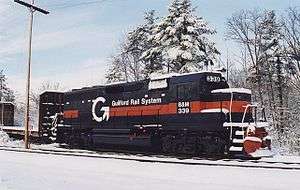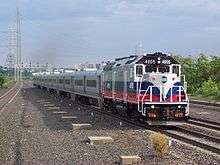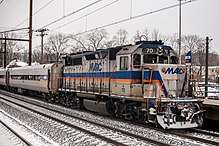EMD GP40-based passenger locomotives
The passenger locomotives derivatives of the General Motors EMD GP40 diesel-electric road switcher locomotive have been, and continue to be, used by multiple passenger railroads in North America. For passenger service, the locomotives required extra components for providing steam or head-end power (HEP) for heating, lighting and electricity in passenger cars. Most of these passenger locomotives were rebuilt from older freight locomotives, while some were built as brand new models.
| EMD GP40-based passenger locomotives | |||||||||||
|---|---|---|---|---|---|---|---|---|---|---|---|
 A GP40 freight locomotive, which served as the basis for many passenger locomotives. | |||||||||||
| |||||||||||
| |||||||||||
| |||||||||||
GP40TC
.jpg)
The GMD GP40TC was built by General Motors Diesel (GMD), for GO Transit in Toronto. Eight units were manufactured between 1966 and 1968. They were built on an enlarged frame to accommodate a head-end power generator.[1]:55 GO Transit sold the fleet to Amtrak in 1988,[2]:106 where they were based in Chicago and used on short-haul trains.
In 2005, the Norfolk Southern Railway rebuilt all eight GP40TC locomotives at its Juniata Shops in Altoona, Pennsylvania.[3] These are now classed as GP38H-3, and work as maintenance-of-way trains or standby power for Downeaster trains.
GP40P
.jpg)
Thirteen GP40Ps were built in October 1968 for the Central Railroad of New Jersey (CNJ) and paid for by the New Jersey Department of Transportation (NJDOT). The CNJ put the units in service on the Raritan Valley Line and the North Jersey Coast Line.
The CNJ's passenger operations were transferred to NJDOT in 1976 (with Conrail operating them under contract), and in 1983 New Jersey Transit assumed operating passenger rail service in the state. Shortly after, the steam generator, which had occupied the flat end of the locomotive's long hood, was replaced with a diesel HEP generator, and the units were reclassified as GP40PH. They would later be rebuilt as GP40PH-2 units in 1991–92.
Southern Pacific ordered a Dash-2 variant of the GP40P; only three of these were ever built. After the conclusion of passenger service, they were repurposed for freight use. All three units are still in service, with two being sent to the Union Pacific Railroad and the remaining one to the Indiana Harbor Belt Railroad.
GP40FH-2

In 1987, New Jersey Transit and Metro-North ordered a set of GP40 locomotives called GP40FH-2s, which were completed by Morrison Knudsen between 1987 and 1990. These locomotives combine the standard cab and frame of a GP40 with the cowl from an ex-Burlington Northern F45 locomotive. A total of 21 units of this type were built; 15 were delivered to New Jersey Transit, and the remaining six were for Metro-North.
As of late 2016, only the Metro-North units remain in service, rebuilt as GP40FH-2Ms. All NJT GP40FH-2 locomotives have been retired following the delivery of the ALP-45DP. Five units were rebuilt into MPI MP20B switchers in 2008. Seven NJT units were purchased by Iowa Pacific Holdings and three of those were designated for use on the Hoosier State between Chicago and Indianapolis before Amtrak took over operations again on January 30, 2017. The rest of the units have been sold to various other operators.
In July 2018, Metro-North Rail Commuter Council's vice chairman announced that the agency is considering purchasing 15 Siemens SC-44 locomotives to replace the current fleet of locomotives for the Port Jervis Line.[4]
GP40PH-2

In 1991–92, NJ Transit sent its ex-CNJ GP40PH units out for rebuilding. The units were rebuilt as GP40PH-2 locomotives.
New Jersey Transit would later order two more sets of GP40PH-2 units; these units were rebuilt from former freight GP40 units. The first order in 1993 consisted of six units rebuilt by Morrison-Knudsen are designated GP40PH-2A. The second order in 1993–94 was for 19 former Penn Central units rebuilt by Conrail. These units are classified as GP40PH-2B.
Metro-North ordered a single GP40PH-2 unit, numbered 4906. It was rebuilt by Conrail in 1992 and is classified as a GP40PH-2M.
Starting in 2014, all but two of NJ Transit's original GP40PH-2s have entered an in-house rebuild program by NJ Transit for a mechanical conversion into a standard GP40-2 for non-revenue service. The HEP motor was removed, unlit number boards were drilled in, the rear ladders were removed and replaced with steps, and LED markers were applied to the rear end of the locomotive, replacing their original tri-color class lights. As of 2020, locomotives 4100, 4101 and 4109 are the only ex-CNJ locomotives that remain in service, along with NJ Transit's GP40PH-2B units and Metro-North's GP40PH-2M unit. The GP40PH-2A units were retired upon the delivery of the ALP-45DP, and they have since been stored, except for one unit, which was sold to MARC.
In December 2017, New Jersey Transit purchased 17 additional ALP-45DPs to replace the remaining GP40PH-2B locomotives that are still in service.[5]
In 2019, NJ Transit unveiled locomotive 4109 painted in a heritage scheme based on that of the CNJ GP40P. 4109, formerly used as a work engine, has since re-entered revenue service.[6]
GP39H-2

In the late 1980s, Morrison-Knudsen rebuilt six GP40s into 12-cylinder GP39s for MARC. They were downgraded from 3,000 horsepower (2,200 kW) to 2,300 horsepower (1,700 kW), and re-equipped with 4-stroke Cummins HEP generators. As of 2015, they continue to be used by MARC for smaller train sets and work train duty.
GP40WH-2

In 1993, Morrison-Knudsen was contacted by the Maryland Transit Administration to assemble a fleet of GP40s for use on MARC. These locomotives essentially combined the frame of a GP40 with radiator sections from a SD45 locomotive and a wide nose and cab from a F45 locomotive. They entered service in 1994. GP40WH-2s are equipped with a Cummins head-end power generator. The Federal Railroad Administration exempted these units from the "triangular light pattern" rule because the engines were ordered with Gyralites before the mandatory use of ditch lights. Since being retired by MARC, most of these units have been rebuilt by MotivePower into MP32PH-Q locomotives for use on SunRail,[7] with the remaining units being sold to other owners. One unit, no. 68, remains for non-revenue work duty and rescue use only.
GP40-2H
In 1996, AMF Technotransport rebuilt six freight locomotives into passenger locomotives for the Connecticut Department of Transportation for use on Shore Line East service. The locomotives, designated GP40-2H, were rebuilt from ex-CSX Transportation EMD GP38s and EMD GP40s. The rebuild included an EMD 645 prime mover, producing 3,000 hp (2,200 kW), and a separate head-end power (HEP) generator.[8]
Following an overhaul performed by National Railway Equipment that began in March 2017,[9][10] all six units were re-designated as GP40-3H and transferred to the newly established Hartford Line service, where they remain in service as of June 2018, though they are still occasionally seen on Shore Line East. Eventually, all other Shore Line East equipment will be moved into service on the Hartford Line once CDOT has sufficient M8 electric multiple units to operate on Shore Line East service.[11]
GP40MC

The Massachusetts Bay Transportation Authority currently owns and operates a set of 25 GP40 passenger diesels known as GP40MCs. They were originally built as GP40-2LWs for Canadian National in 1973-75. In 1997-98, these units were extensively rebuilt by AMF. Although they have been principally used on the lines from North Station, these locomotives can also be seen commonly on the South Station lines. Currently, the GP40MCs are undergoing an overhaul by the Norfolk Southern Railway, which includes repair and modification to the major propulsion systems and the HEP generators.
Since late 2015, the GP40MCs have been mostly replaced by the MPI HSP46, but a handful remain in service.
References
- Wilson, Jeff (2009). The Model Railroader's Guide to Diesel Locomotives. Kalmbach Publishing.
- Solomon, Brian (2004). Amtrak. Saint Paul, Minnesota: MBI. ISBN 978-0-7603-1765-5.
- "AltoonaWorks.info -- AMTK GP38H-3 Rebuilds". www.altoonaworks.info. Retrieved June 19, 2018.
- MTA Board - MNR Committee Meeting - 07/23/2018, July 23, 2018, retrieved August 23, 2018
- "NJ Transit to order more electro-diesels". International Rail Journal. December 8, 2017. Retrieved December 8, 2017.
- https://trn.trains.com/news/news-wire/2019/10/08-nj-transit-provides-more-details-on-heritage-units
- "SunRail, Sound Transit order MotivePower locomotives". Trains. September 12, 2011. Retrieved September 13, 2011.
- "NRE to overhaul Connecticut DOT commuter rail locomotives". Trains News Wire. March 20, 2017. Retrieved March 21, 2017. (subscription required)
- http://trn.trains.com/news/news-wire/2017/03/20-nre-to-overhaul-connecticut-dot-commuter-rail-locomotives
- http://www.ttmg.org/blog/tag/gp40-2h/
- "Expanding Rail Service" (PDF). Connecticut Department of Transportation. January 1, 2007. Retrieved March 21, 2017.
Further reading
- Moran, Miles (1975). "And Passenger Service Too". Railroad Modeler. 5 (8): 40–47.